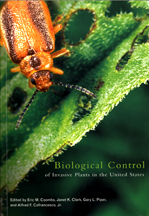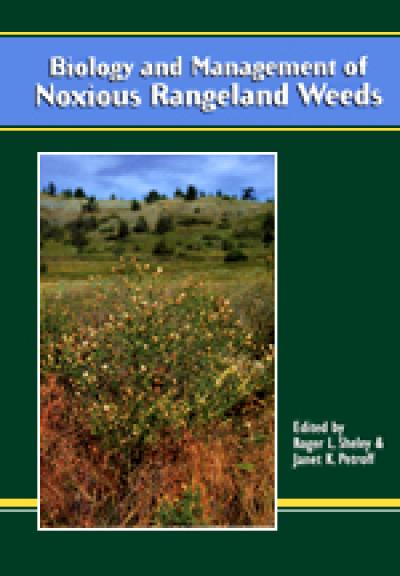
Biological Control of Invasive Plants in the United States
Janet K. Clark, Gary L. Piper, Eric M. Coombs, and Alfred F. Cofrancesco Jr.
Undesirable invasive plants are infesting public and private lands and waterways in this country at an alarming rate. Various methods are used to suppress these nonnative weeds, from herbicides to burning to cultivation. Classical biological control-in which selected host-specific, plant-attacking insects, mites, nematodes, and pathogens are introduced from the invasive plant's native lands-provides an additional tool for land managers.
In this book, leading experts review the discipline of biological control of invasive terrestrial and aquatic plants. Topics addressed include ecology, safety testing, nontarget impacts, and the processes of identifying, introducing, distributing, and monitoring biological control agents.
This book also provides information about 39 target plants in the continental United States and 94 agents, including their origin, biology, habitat, impacts, and distribution. The book concludes with information about invasive plants targeted for biological control in the future.
An invaluable reference for land managers, natural resource and weed control specialists, and students of natural resource management, Biological Control of Invasive Plants in the United States provides practical, science-based information needed for understanding and using biological control as part of an integrated invasive-plant management strategy.
About the author
Janet K. Clark is Director of the Center for Invasive Plant Management at Montana State University and co-editor of Biology and Management of Noxious Rangeland Weeds (OSU Press).
Read more about this author
Gary L. Piper is Associate Professor of Entomology and Biological Control of Weeds Specialist at Washington State University.
Read more about this author
Eric M. Coombs is Biological Control Entomologist for the Oregon Department of Agriculture.
Read more about this author
Alfred F. Cofrancesco Jr. is Technical Director, Environmental Engineering and Sciences, for the US Army Corps of Engineers in Vicksburg, Mississippi.
Read more about this author
Foreword .......................................................................................... viii
Introduction......................................................................................... 1
I. The Theory and Practice of Biological Control
The Ecology of Biological Control ...................................................... 15
Foreign Exploration ........................................................................... 27
Host Specificity Testing of Biological Control Agents
of Weeds .................................................................................... 32
Technical Advisory Group for Biological Control Agents
of Weeds .................................................................................... 38
Permitting ......................................................................................... 42
Documentation ................................................................................. 47
Plant Pathology and Biological Control of Invasive Weeds ............... 50
Handling Terrestrial Biological Control Agents .................................. 59
Post-Release Procedures for Biological Control Agents of
Aquatic and Wetland Weeds....................................................... 71
Factors That Affect Successful Establishment of Biological
Control Agents ........................................................................... 85
Monitoring in Weed Biological Control Programs............................... 95
Nontarget Impacts of Biological Control Agents ............................. 106
Integrated Weed Management and Biological Control ................... 114
Economic Benefits of Biological Control ........................................... 122
The Role of Private Industry in Biological Control of Weeds ............ 127
International Code of Best Practices for Classical
Biological Control of Weeds ...................................................... 130
II. Target Plants and the Biological Control Agents
Alligatorweed .................................................................................. 139
Bindweeds ...................................................................................... 150
Brooms ........................................................................................... 158
Eurasian watermilfoil ...................................................................... 169
Giant salvinia .................................................................................. 174
Gorse .............................................................................................. 178
Hydrilla ............................................................................................ 184
Knapweeds ..................................................................................... 197
Leafy spurge ................................................................................... 236
Mediterranean sage ........................................................................ 267
Melaleuca ........................................................................................ 272
Puncturevine ................................................................................... 280
Purple loosestrife ............................................................................ 285
Rush skeletonweed ........................................................................ 296
Russian thistle ................................................................................ 306
Saltcedar ........................................................................................ 313
Smooth cordgrass ........................................................................... 319
St. Johnswort .................................................................................. 324
Tansy ragwort ................................................................................. 337
Thistles ........................................................................................... 346
Toadflax .......................................................................................... 379
Tropical soda apple ......................................................................... 395
Waterhyacinth ................................................................................ 402
Waterlettuce .................................................................................. 414
Yellow starthistle ............................................................................ 421
III. New and Ongoing Biological Control Projects in the United States
Brazilian peppertree........................................................................ 439
Cape ivy .......................................................................................... 441
Common buckthorn ......................................................................... 442
Common teasel ............................................................................... 442
Garlic mustard ................................................................................. 443
Giant reed ....................................................................................... 443
Hawkweeds .................................................................................... 444
Houndstongue ................................................................................ 445
Japanese knotweed ....................................................................... 446
Medusahead ryegrass .................................................................... 446
Old World climbing fern ................................................................... 447
Skunk vine ...................................................................................... 449
Sulfur cinquefoil ............................................................................... 450
Water chestnut ............................................................................... 451
Whitetop / Hoary cress ................................................................... 452
Authors, Editors, and Contributors ................................................. 453
Index .............................................................................................. 456




